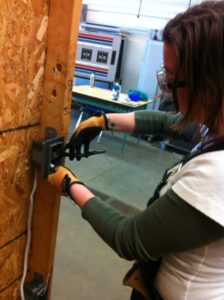The Women in Trades Training (WITT) program at Camosun College offers an overview of the trades, helping women trying to figure out their career path or looking to make a change to decide if trades is right for them.
The latest WITT program offers a marine focus; 13 women have spent the last 12 weeks working with instructors and going on day trips to various job sites, including going to Seaspan Shipyard, taking a sail with BC Ferries, and getting a tour of Quadrant Marine in Canoe Cove. One of the women in the program is former stay-at-home mom, 34-year-old Lyndsey Tremblay.
“When I left my ex-husband, I decided I needed to have a career that was going to be able to provide for myself and my son,” says Tremblay. “And going the trades route right now is the way to go.”

Tremblay had an inkling before going into the program that she wanted to become a pipefitter, but says this experience helped solidify her decision.
“My dad and I kind of discussed what was coming up in the trades and what was going to be the future of the trades in our province,” says Tremblay, whose father is a sheet metal journeyman. “Pipefitting and gasfitting is going to be a big thing. So, I went, ‘Well, that’s where I want to go, then.’ And it confirmed it once I got into the class and I was able to do some hands-on. I really enjoyed it.”
Tremblay’s classmate Erika Scherschel has found this experience equally helpful in deciding what trade to pursue.
“This process has confirmed that I want to do welding,” says Scherschel, who had an interest in the trade before starting the program. “I have a friend that I used to work with many years ago, and she’s a welder, and she loves it. And I have an aunt who does a lot of art with metal and welding with metal, and that sort of piqued my interest in it.”
Although she didn’t join the program specifically for its marine focus, Scherschel says it’s helped her realize her ultimate career goals.
“My dream is to work with Seaspan as a welder,” she admits. “They’re such an impressive company on paper. Their safety practices are incredible. They really care about their employees and it shows. They also really care about the environment, and that’s something that’s really important to me. And the other thing is they’re really into diversity. They’re one of the sites we saw that had the most girls. They had girls in every department. They had girls talk to us. They’re starting to see the advantages of women in the trades and they’re really trying to get on that.”
The lack of women in the male-dominated trades is a sensitive topic that’s been discussed by these students and their instructors, who are mostly male.
“It usually starts, generally, they’ll call us ‘guys’ and then go, ‘Oh, I’m so sorry, is that okay?’ And we’re all like, ‘Yeah, that’s fine.’ We don’t mind,” says Tremblay.
WITT homeroom instructor Steve Anderson, who spent 35 years in the production shops in the Naval dockyards, was inspired to come out of retirement to be involved in this program and advocate for women in trades.
“I apprenticed in 1974 and there were no women in the dockyards and the trades at that time. In the shipyards, in particular, they were just non-existent. And now, it’s just mainstream. It’s really encouraging to go down to these shipyards and, whether it’s the older fellas or the new, young apprentices, the males, they just accept them as equal so it’s really, really changed and probably in the last 10 to 15 years, there’s just been a huge change,” says Anderson.
While all three admit there is going to be the odd person who has an issue with women in trades, the men involved with program have been supportive.
“They just want us there. They want to share their knowledge,” says Tremblay. “They know there’s a gap coming up between skilled workers and those that are retiring. We’re the ones that are going to fill it.”
